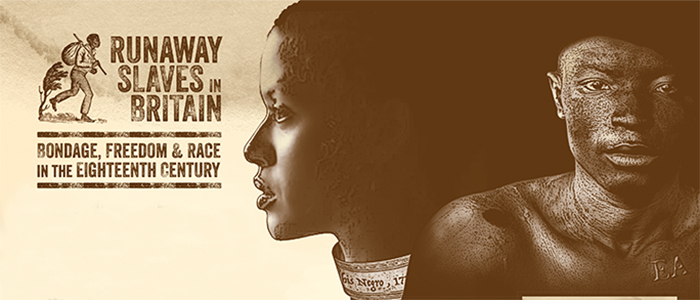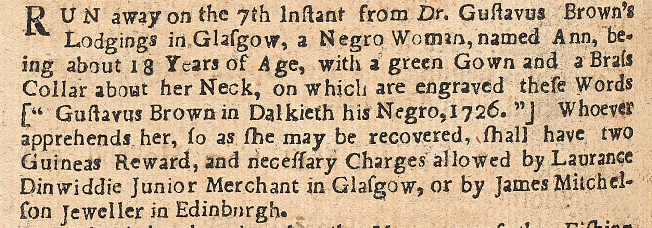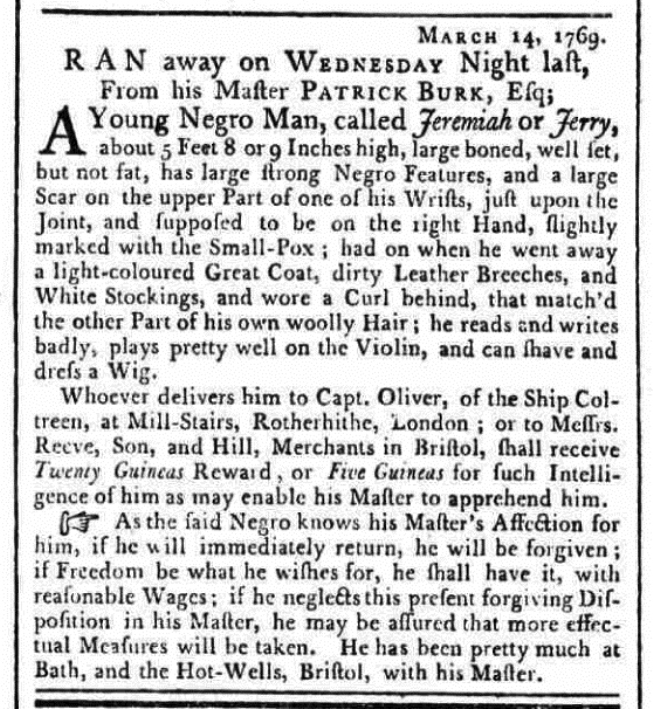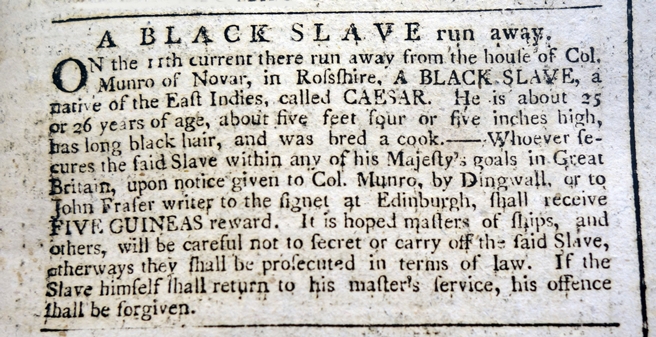Runaway Slaves in Britain searchable database launched
Published: 1 June 2018
Academics at the University of Glasgow have launched a new digital database of fugitive slave adverts from 18th century UK newspapers.

After hours of research through thousands of newspaper pages academics at the College of Arts have launched a new digital database of fugitive slave adverts from 18th century UK newspapers.
The database is a result of the Runaway Slaves in Britain project and reveals hundreds of stories of enslaved and bound people who had escaped their captivity.
More than 800 advertisements from 18th century newspapers were placed by masters and owners offering rewards to anyone who captured and returned the runaways.
They represent a far larger number of enslaved and bound people, as many masters did not place newspaper advertisements, and a great many slaves and bound servants do not appear to have tried to escape.
Most runaways were of African descent, though a small number were from the Indian sub-continent and a very few were Indigenous Americans.
The advertisements paint a fascinating picture of the men, women and children who ran away in an attempt to be free of servitude providing a rich source of information about the enslaved and slavery in 18th century mainland Britain.
The written notices described the mannerisms, clothes, hairstyles, skin markings, and skills of people who otherwise would have been completely absent from the official historical records of the time.
The advertisements also include information about the work of the enslaved, their homes and situations, and the lives, businesses and homes of their masters and mistresses.
Some of the runaway slaves were employed as sailors and dock workers, as well as, craftsmen, labourers and washerwomen.
The large majority were domestic servants and workers in the households of elite and mercantile families who had spent time in or had connections with the British Empire’s colonies.
An advert from the Edinburgh Evening Courant dated 13 February 1727, from The Mitchell Library, Glasgow, stated: “Run away on the 7th instant from Dr Gustavus Brown’s Lodgings in Glasgow, a Negro Woman, named Ann, being about 18 Years of Age, with a green Gown and a Brass Collar about her Neck, on which are engraved these words [“Gustavus Brown in Dalkieth his Negro, 1726.”] Whoever apprehends her, so as she may be recovered, shall have two Guineas Reward, and necessary Charges allowed by Laurence Dinwiddie Junior Merchant in Glasgow, or by James Mitchelson Jeweller in Edinburgh.

© Special Collections/ The Mitchell Library/Museums and Collections/Glasgow Life
The principal sources for the project are English and Scottish newspapers published between 1700 and 1780. The database covers all the regions of England and mainland Scotland.
Professor Simon Newman, Professor of History at the University’s College of Arts, said: “We do not have the words or sometimes even the names of bound or enslaved people who were brought to 18th century Britain. In many cases all that remains are the short newspaper advertisements written by masters who were eager to reclaim their valuable human property.
“These advertisements are important because they remind us that slavery was routine and unremarkable in Britain during the first three-quarters of the 18th century. This is made very clear by the placement of these newspaper notices offering enslaved people for sale or seeking the recapture and return of enslaved runaways. These advertisements appeared next to the mundane and every day news items and announcements that filled the pages of the burgeoning newspaper press.
“Slavery was not an institution restricted to the Caribbean, America or South Asia, and these short newspaper notices bring to life the enslaved individuals who lived, worked, and who attempted to escape into British society.
“This is an important resource for the understanding of slavery and telling the stories of the enslaved and slavery in Britain.”
Nelson Mundell, a research assistant on the project, said: “This project shows that it wasn’t an unusual thing to have slaves walking around the streets of villages, towns and cities the length and breadth of Britain.
“The adverts make for sobering reading as they describe scars and markings from whips or brands.
“It also shows that on occasion slaves wore collars or other manacles, sometimes with owner’s name engraved on them, as was the case with an 18-year-old fugitive called Ann who escaped from a house in Glasgow.”
The Runaway Slaves in Britain project is based upon extensive and painstaking research into dozens of Scottish and English newspapers to locate advertisements.
While a few of these newspapers have been digitised, the quality of the original print and scans (often of microfilm) is such that digital text searching misses as much as it finds, so the research has involved combing through tens of thousands of pages of newspapers in order to find runaway advertisements.
The database contains full transcriptions of advertisements, and when possible photographic reproductions.
The project’s website include a guide to further reading and web resources, as well as, resources designed to make this data useful to school teachers and their pupils.
Research from the project has already helped inspire a graphic novel (entitled Freedom Bound and due to be published later this year), the award-winning short film ‘1745’ (2017, dir. Gordon Napier), and a variety of radio programmes and other outputs.
This project has been made possible by support from the Leverhulme Trust, and from the University’s College of Arts.
Sample advertisements found on the new searchable Runaway Slaves in Britain database:-
Jeremiah - Bath Chronicle and Weekly Gazette, 16 March 1769, p.4.
March 14, 1769.
RAN away on WEDNESDAY Night last,
From his Master PATRICK BURK, Esq;
A Young Negro Man, called Jeremiah or Jerry, about 5 Feet 8 or 9 Inches high, large boned, well set, but not fat, has large strong Negro Features, and a large Scar on the upper Part of one of his Wrists, just upon the Joint, and supposed to be on the right Hand, slightly marked with the Small-Pox; had on when he went away a light-coloured Great Coat, dirty Leather Breeches, and White Stockings, and wore a Curl behind, that match’d the other Part of his own woolly Hair; he reads and writes badly, plays pretty well on the Violin, and can shave and dress a Wig.
Whoever delivers him to Capt. Oliver, of the Ship Coltreen, at Mill-Stairs, Rotherhithe, London; or to Messrs. Reeve, Son, and Hill, Merchants in Bristol, shall receive Twenty Guineas Reward, or Five Guineas for such Intelligence of him as may enable his Master to apprehend him.
As the said Negro knows his Master’s Affection for him, if he will immediately return, he will be forgiven; if Freedom be what he wishes for, he shall have it, with reasonable Wages; if he neglects this present forgiving Disposition in his Master, he may be assured that more effectual Measures will be taken. He has been pretty much at Bath, and the Hot-Wells, Bristol, with his Master.

© The British Library Board and British Newspaper Archives (www.britishnewspaperarchive.co.uk)
Caesar - Edinburgh Evening Courant, 22 June 1771, p.3.
A BLACK SLAVE run away.
ON the 11th current there run away from the house of Col. Munro of Novar, in Rossshire, A BLACK SLAVE, a native of the East Indies, called CAESAR. He is about 25 or 26 years of age, about five feet four or five inches high, has long black hair, and was bred a cook. - Whoever secures the said Slave within any of his Majesty’s goals in Great Britain, upon notice to Col. Munro, by Dingwall, or to John Fraser writer to the signet at Edinburgh, shall receive FIVE GUINEAS reward. It is hoped masters of ships, and others, will be careful not to secret or carry off the said Slave, otherways they shall be prosecuted in terms of law. If the Slave himself shall return to his master's service, his offence shall be forgiven.

© The British Library Board and British Newspaper Archives (www.britishnewspaperarchive.co.uk)
First published: 1 June 2018
Find out more
- Professor Simon Newman - Research Profile
- Nelson Mundell - Research Profile
- School of Humanities | Sgoil nan Daonnachdan
- College of Arts
- Leverhulme Trust
- Runaway Slaves in Britain - website
- Runaway Slaves in Britain - database

